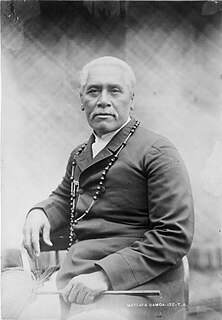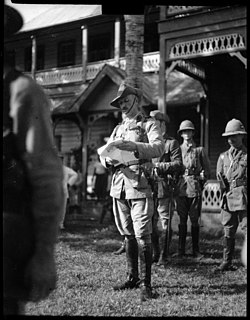 W
WGerman Samoa was a German protectorate from 1900 to 1914, consisting of the islands of Upolu, Savai'i, Apolima and Manono, now wholly within the independent state of Samoa, formerly Western Samoa. Samoa was the last German colonial acquisition in the Pacific basin, received following the Tripartite Convention signed at Washington on 2 December 1899 with ratifications exchanged on 16 February 1900. It was the only German colony in the Pacific, aside from the Kiautschou Bay concession in China, that was administered separately from German New Guinea.
 W
WThe Occupation of Samoa was the takeover – and subsequent administration – of the Pacific colony of German Samoa by New Zealand during World War I. It started in late August 1914 with landings by the Samoa Expeditionary Force from New Zealand. The landings were unopposed and the New Zealanders took possession of Samoa for the New Zealand Government on behalf of King George V. The Samoa Expeditionary Force remained in the country until 1915, while its commander, Colonel Robert Logan, continued to administer Samoa on behalf of the New Zealand Government until 1919. The takeover of Samoa was New Zealand's first military action in World War I.
 W
WMata'afa Iosefo was a Paramount Chief of Samoa who was one of the three rival candidates for the kingship of Samoa during colonialism. He was also referred to as Tupua Malietoa To'oa Mata'afa Iosefo. He was crowned the King of Samoa on the 15th of November 1898.
 W
WRobert Logan was an officer in the New Zealand Military Forces who served in the First World War as the Military Administrator of Samoa.
 W
WLauaki Namulau'ulu Mamoe was a renowned orator chief and the first leader of the Mau, a resistance movement in Samoa during colonialism. Mamoe was exiled to Saipan in 1909. He died in 1915 as he was taken back to Samoa.
 W
WTa'isi Olaf Frederick Nelson was a Samoan businessman and politician. He was one of the founding leaders of the anti-colonial Mau movement.
 W
WWilhelm Heinrich Solf was a German scholar, diplomat, jurist and statesman.